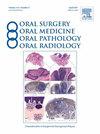Stress Distribution in Modified Veneer Crowns: 3D Finite Element Analysis
Oral surgery, oral medicine, oral pathology, oral radiology, and endodontics
Pub Date : 2021-09-16
DOI:10.3390/oral1030026
引用次数: 2
Abstract
(1) Background: to propose a new approach for crown veneers, with the use of an aesthetic porcelain coating, only in part of the zirconia infrastructure, and to analyze its biomechanical behavior to minimize chipping failures. (2) Methods: a maxillary molar was modeled using CAD software, preparing for traditional crowns and veneer crowns with various lengths. Five groups were formed: M—control group (monolithic crown of ultra-translucent zirconia); B—conventional (bilayer crown of ultra-translucent zirconia and ceramic covering); V—veneer (ultra-translucent zirconia crown with reduction only in the buccal and application of covering ceramics); V1—ultra-translucent zirconia crown with buccal reduction and 1 mm occlusal extension for covering ceramic application); V1.5—ultra-translucent zirconia crown with buccal reduction and 1.5 mm occlusal extension for application of covering ceramics. A load of 600 N was performed axially to a fossa bottom to simulate parafunction, and 300 N to the cusp tip to obtain the maximum principal stress results. (3) Results: group B showed a higher stress concentration in the occlusal region of the restorations, while the other groups absorbed the stress and dissipated it throughout the crown, presenting a higher stress concentration in the interface region with the tooth. (4) Conclusion: the highly translucent zirconia ceramic only associated with buccal covering ceramic could add aesthetic gain and rigidity to the system and could be a good option to restore maxillary molars in patients who do not have parafunction.改良牙冠的应力分布:三维有限元分析
(1)背景:提出一种冠贴面的新方法,使用美观的瓷涂层,仅在部分氧化锆基础结构中使用,并分析其生物力学行为,以减少切屑失败。(2)方法:采用CAD软件对上颌磨牙进行建模,制备不同长度的传统冠和贴面冠。分为五组:m -对照组(超半透明氧化锆整体冠);b -常规(超透明氧化锆和陶瓷覆盖的双层冠);v -贴面(超半透明氧化锆冠,仅在颊部还原,并应用覆盖陶瓷);v1 -超半透明氧化锆冠,下颌复位,咬合延伸1mm,用于覆盖陶瓷应用);v1.5 -超半透明氧化锆冠,下颌复位,咬合延伸1.5 mm,用于覆盖陶瓷。对凹底施加600 N的轴向载荷以模拟副功能,对尖尖施加300 N的轴向载荷以获得最大主应力结果。(3)结果:B组修复体咬合区应力集中较高,而其他组在全冠上吸收并消散应力,与牙体界面区应力集中较高。(4)结论:高度半透明的氧化锆陶瓷仅与颊覆盖陶瓷联合使用,可增加系统的美观性和刚性,是无功能障碍患者上颌磨牙修复的良好选择。
本文章由计算机程序翻译,如有差异,请以英文原文为准。
求助全文
约1分钟内获得全文
求助全文
来源期刊
自引率
0.00%
发文量
0
审稿时长
1 months

 求助内容:
求助内容: 应助结果提醒方式:
应助结果提醒方式:


